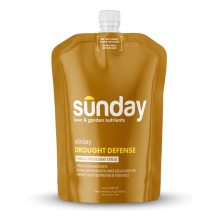When rainfall is scarce and water shortages hit, it's a tough time for the entire ecosystem, including your lawn. Watching your green lawn fade under the stress can be difficult, and it’s a time when the goal of lawn care shifts from your grass thriving to simply surviving.
Reading the signs of a drought-stressed lawn
A drought-stressed lawn will send clear signals that it needs a change in care.
- Footprints linger: Walk across the grass. If your footprints remain visible for a long time, the grass blades lack the moisture needed to spring back.
- Blades turn blue-gray: The grass will take on a subtle, bluish-gray tint before it begins to turn brown or tan.
- Leaves fold: Grass blades will fold in half lengthwise to conserve water, making the lawn look thin and spiky.
- Growth comes to a halt: Your lawn will dramatically slow or even stop growing entirely to conserve energy.
Recognizing these early warnings allows you to shift to a drought care strategy before the lawn suffers permanent damage.
How to keep your grass alive during drought
When drought conditions begin, your lawn care routine needs to change. Conventional practices can cause more harm than good during prolonged or severe drought.
Modify your mowing
Your mower is a powerful tool for drought defense.
- Raise your mowing deck to the highest possible setting. Taller grass provides more shade for the soil, which reduces evaporation and keeps the roots cooler.
- It’s also crucial to use a very sharp mower blade. A clean cut helps the grass heal faster and lose less water.
Sunday Tip:
If your lawn has stopped growing completely, stop mowing. Pushing a mower over a dormant lawn can damage the crowns of the grass plants, making recovery more difficult.
Water smarter (not harder)
When watering is restricted, every drop counts. The goal is to get the water you can use deep into the soil where the roots are.
- Water in the early morning: The best time to water is between 4 a.m. and 8 a.m. This minimizes water loss from wind and evaporation in the midday heat.
- Focus on depth: It's better to water deeply once than to sprinkle lightly several times. Use a screwdriver or soil probe to check penetration. If it slides easily 6 inches into the ground, you’ve watered effectively.
Sunday Tip:
If your soil is so dry that it repels water, here's what to do: 1. Apply a quarter-inch of water. 2. Wait 30 minutes. 3. Apply another quarter-inch of water. This prevents water loss and helps moisture reach root zones where it's needed most.
Apply Drought Defense
For extremely dry soil that repels water, a product like Sunday's Drought Defense can be a powerful tool. It utilizes surfactant technology to enhance water penetration in the soil, maximizing the use of every drop.
Sunday Tip:
When applied before or during drought conditions, Drought Defense helps your lawn reduce water needs by up to 20%.

Drought Defense Lawn Treatment
- 0-0-1 NPK liquid lawn fertilizer
- Drought resiliency
- Reduced water use
- Made for all grasses
Reduce lawn stress
A drought-stressed lawn is vulnerable. Minimize all other lawn stressors to give it the best chance of survival.
- Avoid heavy foot traffic, as this can crush dry, brittle grass blades.
- Postpone any plans for fertilization. Fertilizing during drought can push new growth that the lawn can't support with limited water (or already stressful conditions).
Sunday Tip:
For play areas that must remain accessible to children or pets, consider watering the grass lightly before use to make the blades more flexible and resilient to activity.
When to let your lawn go dormant in drought
In a severe or prolonged drought, the smartest thing you can do is let your lawn go dormant. This is a natural self-preservation mode where the blades turn brown to conserve energy, while parts like the crown and roots stay alive. A common mistake is trying to fight this process with light, frequent watering. This wastes water and can drain the plant's energy reserves, making recovery harder.
Work with your lawn's dormancy
A dormant lawn only needs a minimal amount of water to keep the crowns from completely drying out. Provide about a quarter-inch of water every two to three weeks. This "maintenance watering" won't turn the grass green, but it provides just enough to help it survive and recover when the drought ends.
Post-drought lawn recovery
When the drought finally breaks, be patient. Your lawn needs time to recover before it's ready for a normal routine.
- Water gradually: For the first week or two, introduce deep, infrequent watering to help the roots reestablish.
- Wait to fertilize: Resist the urge to fertilize immediately. This can force weak top growth before the root system is ready. Wait until the lawn is consistently green and growing again before resuming your Sunday plan.
- Repair bare patches: Once the lawn has mostly recovered, you can address any areas that didn't survive by overseeding with high-quality drought-tolerant lawn seed.
Sunday Tip:
A lawn that was managed properly during dormancy will typically green up within two to three weeks of significant rainfall or good irrigation.
Growing a drought-tolerant lawn and yard
These proactive steps create naturally drought-resistant landscapes that require less intervention during inevitable water shortages ahead.
Improve your soil
Healthy soil holds more water. Amending your soil with compost helps it act like a sponge, providing moisture to grass roots long after it rains.
Choose drought-tolerant seed
The foundation of a drought-resistant lawn is the grass itself. When you repair patches or overseed, choose drought-tolerant lawn seed. These modern varieties are bred to grow deeper roots and use water more efficiently, resulting in a healthier lawn that requires less water.
Consider lawn alternatives
In sunny, hard-to-water areas, consider replacing sections of your lawn with drought-adapted native plants or groundcovers to create a beautiful and resilient landscape.
Grow a lawn that's drought-ready
A Sunday custom plan is your proactive step towards a more resilient yard. Our science-backed approach focuses on healthy soil and deeper roots, creating a drought-tolerant lawn that requires less water.
Cited sources
Drought Conditions Continue in Spring 2021.
Lawn Care Tips to Save Water During Drought (drought). University of Nebraska-Lincoln.
Managing Lawns During Drought - Lawn Talk. University of Illinois Urbana-Champaign.
United States Drought Monitor. University of Nebraska-Lincoln.












